2016 Yeti SB5.5 Carbon X01
(discontinued)
| Where To Buy | |||
|---|---|---|---|
Free shipping on orders over $50 (continental U.S. only).
International shipping available. Some exclusions apply. |
|||
Free shipping on orders over $50 (continental U.S. only).
International shipping available. Some exclusions apply. |
|||
Review by Jeff Brines // Action photos by Matthew Doreghty
We’ve spent the better part of two months testing Yeti’s latest big-wheeled all-mountain brawler, the SB5.5c, and for the right rider it could be one of the best performing frames. Should you add the bike to your stable? How could it be improved? Read on to find out.

The SB5.5c was unveiled earlier this Spring in Moab, during which we received the bike quiet favorably. However, Moab is an outlier of "normal riding conditions," which is why we reserved our full opinion of the new steed until we had ample time to test the rig in a number of riding environments.
In two months we’ve done our best to put the SB5.5c through every kind of riding we can muster, from 40-mile desert XC races to full on downhill laps. Though the SB5.5c may have been created as a specialized tool designed to destroy the likes of the Enduro World Series, we utilized it as a do-everything rig to see where it slots in best. There was no riding situation (on dirt anyway) that we shied away during over 1,000 miles (1,600km) and 125,000 feet (38,000m) of ascending/descending. We rode this thing day in and day out with little consideration given to weather or what the ol' legs were saying.
Highlights
- High modulus carbon fiber frame
- 29-inch wheels
- 140mm (5.5-inches) rear travel // 160mm (6.3-inches) front travel
- Switch Infinity suspension
- Collet pivot axle system
- Internal cable routing
- PF92 bottom bracket with ISCG05 tabs
- Tapered 44/56mm headtube
- Boost 148x12mm rear axle
- Custom downtube protector and chain guards
- Not compatible with front derailleur or 27.5+ tires
- Frame weight: 6.0-pound (2.72kg)
- Measured complete weight (size XL, with pedals): 30.0-pounds (13.6kg)
- MSRP $6,999 USD
Geometry
At 6'2" (1.88m) tall, I never felt cramped on the size XL frame, but do find it noteworthy that Yetis are no longer the outliers of sizing they once were. This isn’t because Yeti shrunk their bikes, but rather the rest of the industry caught on to what they’ve been preaching for over a decade. That said, if anything, the XL SB5.5c is on the shorter end the spectrum when compared to others in the “long and slack” 29er category. For example, it has a reach measurement of 463mm (18.2-inches) compared to the Transition Smuggler at 483mm (19.0-inches) and Evil Wreckoning at 472mm (18.6-inches).

The SB5.5c has a head angle of 66.5-degrees and fork offset of 44mm according to Steve "Hoog" Hoogendoorn, VP of Yeti Cycles, so the bike rides as though it has a slightly slacker head angle than the number implies (most 29ers feature a 51mm offset). When these geometry numbers are coupled with 437mm (17.2-inch) chainstays and a 346mm (13.6-inch) bottom bracket, the bike struck an incredibly balanced feel, especially in the longer XL variant. We’ll touch on those findings further, below.
Switch Infinity Link Suspension
The SB5.5c is driven by Yeti’s patented Switch Infinity Link. Though it looks complicated at first glance, the function of the translating main pivot is actually fairly simple - it allows the suspension’s instant center to move as the bike cycles through its travel. This design allows Yeti, as they put it, to independently tune pedaling performance from bump eating ability with little compromise between the two attributes. At the beginning of the travel the Switch Infinity system moves upward. Once it reaches the inflection point it reverses directions, preventing the chain force from adversely affecting the suspension performance and giving the suspension a controlled feel.
The bike has fairly high anti-squat properties with the stock 30-tooth chainring, especially in the middle/lower part of the cassette. Bike geekery and numbers aside, the SB5.5c is sprightly on the gas and seldom left me searching for the shock’s lockout lever. According to the data, a larger chainring would only yield better anti-squat properties (closer to 100%), making it a good fit for SRAM’s new Eagle drivetrain.

Setting up the SB5.5c’s suspension is easy enough, but eeking that last little bit of potential is another thing altogether. As I found myself in more demanding riding situations, I added more and more pressure to the rear shock as the bike seemed to utilize more of its travel than I’d prefer. Like all of Yeti’s SB bikes, the bike has a relatively flat leverage ratio curve, relying more on the shock than its linkage to control the progressiveness of the stroke. In general this makes sense as air shocks are progressive by nature. However, in recent years, many suspension companies have flattened out the curve of their air springs through use of more aggressive negative springs and larger volume air cans. The bike is equipped with FOX's Factory Float X shock featuring an EVOL air can, which resulted in incredible breakaway and small bump performance, but seemed over zealous in its utilization of travel at times. This was not something I noticed until my speeds started picking up. For certain conditions, riding styles, rider weights, or terrain, simply setting sag to the appropriate level and dialing in rebound may be all that is required.
Later in the test I added a larger volume spacer inside the air can, increasing the overall rate at which the shock ramped up. Bingo. The bike responded to my inputs better, stayed higher in the travel and more neutral while cornering, and was less likely to get hung up in holes or on ledges. All this added up to faster and more consistent riding.
Many have asked me to comment on the 140mm travel rear end paired with a 160mm front end. To be honest, if Yeti never told me the travel difference (and I never measured), I would have guessed the front and back were equally matched. It never felt unbalanced, especially once tuned for my weight and riding style.

The only other caveat to the bike’s suspension is that I ended up maxing out the rebound adjuster (full slow) and still desired more damping at times. Clearly Yeti is using the same rebound (and likely compression) tune on all sizes of bikes. At 200-pounds I'm a heavy rider and running more air pressure than most riders, hence the demand for more rebound damping. Still, the company should consider a heavier rebound tune for the XL and Large sizes.
Overall the bike’s suspension is very well designed, giving good control over a number of tuning variables without being overly hard to get close to perfect or overwhelm the rider who "just wants to ride." Still, one can only wonder how much more performance one could find when the SB5.5c is paired with a top-of-the-line downhill shock like FOX’s Float X2, the same shock Yeti’s team is often seen running. Yeti does claim a coil-over shock works, however we feel air may be more appropriate for more aggressive riders as one can alter the progressiveness of the travel via volume spacers.
On The Trail
Test environments included Moab, Grand Junction, Denver’s Front Range, and Jackson, Wyoming. Being it was tested in the Spring, the bike saw snow, sleet, hail, mud, and the moon dust that eventually follows.
I’ll get the boring stuff out of the way first. The bike is efficient and climbed well, as my willingness to enter the 40-mile Grand Junction Off-Road XC race should speak to. Despite starting in the back of the field, I still finished the race semi-respectably and had a whole lot more fun on the descents than the majority of the field on XC bikes. The frame is around 6-pounds, and the complete bike weighs exactly 30-pounds with real tires and pedals. If one were to open their pocketbook, a sub 28-pound bike is very possible without much sacrifice in durability or descending performance.
The more demanding the climb was in technicality, the more I was impressed with the SB5.5c. I found myself consistently cleaning sections of trail that previously took me entire seasons to nail just once or twice. Don’t get me wrong, the SB5.5c is not an XC race rig, but it is as efficient of a long-travel bike as I’ve ridden. The Switch Infinity Link does a good job keeping things active while remaining efficient, and the larger wheels offer gobs of traction and rollover. Just stay on line and keep those pedals turning and you’ll get through some pretty hairy sections of trail. The 346mm bottom bracket, though a bit higher than the competition, was appreciated in these situations.

When the trail turns downhill, there are a few things that stand out. First, the bike is solid - one of the stiffest trail bike chassis I’ve ever ridden. Second, the bike is balanced, offering a fairly big sweet spot and making it easy to properly weight the bike. Third, it's playful, easy to put in the air, and fun to push in the corners. Finally, the SB5.5c levels terrain in a way only a wagon-wheeled long-travel trail bike will allow.
Though the bike’s chainstay length isn't long at 437mm, they are about 6-8mm (1/4-inch) longer than most of the competition (Pivot Switchblade or Evil Wreckoning, for instance). Some may complain about this, especially in the smaller sizes. However, paired with a slightly shorter reach in the XL, it allowed me to more easily weight the front wheel while remaining in the middle of the bike. Anyone who has been following World Cups can attest to chainstay length being the special sauce for a number of riders including Greg Minnaar and Aaron Gwin. Like the mounting position of a ski binding, there is no perfect length as rider style, the bike’s intended use, reach, head angle, fork trail, etc, all play together. When putting the bike on the scales, I found the weight distribution (with me in a neutral position) to be 48% front and 52% rear, which would offer some objective confirmation as to why I felt so balanced.
The SB5.5c cornered well, putting to rest the idea that larger wheels struggle when changing direction. However, the bike asks to be piloted aggressively to get it to perform. If I got lazy, passive, or wasn’t feeling all that committed to a corner, I was penalized and found it harder to recover from these errors compared to a smaller wheeled bike. On the contrary, if I was aggressive, committed to the corner, and looked as far ahead as possible, I found myself consistently carrying more speed than just about any bike I’ve ever ridden.

The combination of stiff, wide wheels (30mm internal), and a laterally stiff frame put to rest another of my main complaints of 29ers of the past – flex. I didn’t feel the bike squirm when tipped over which is one major reason I found it to felt so capable in the twisties.
Smashing the bike through rooty, hole infested trail yielded a very interesting blend of monster truck ability with a sports car feel. I could passively lean back and hold on, or I could work the bike by actively looking for every backside possible, both with excellent results. The bike was surprisingly easy to put in the air, which left me doubling sections of trail I’ve never attempted nor imagined I could clear in the past. Again, this comes back to the top-notch suspension design, well-thought-out geometry, and those big ol' wheels that carry momentum better than their 27.5 (650b) brethren.
Overall I was a more consistent descender on the SB5.5c, hitting my lines as intended more often. Though my sample size is low, a bit of objective timed training did confirm this consistency as the standard deviation of my times was lower when compared to my 27.5 bike which features more rear travel.
I realize the comments section may blow up with what I’m about to say, but this bike descended so well that I have to wonder if a 29-inch downhill bike doesn’t make sense for a taller rider on the World Cup circuit. Considering wheel stiffness is no longer the issue it once was and fork offset is largely figured out, it would be very interesting to see a taller pilot aboard a downhill-specific 29-inch bike. But I digress from the point of this review...
Build Kit
We covered the basics in our First Look feature and will do our best not to rehash those findings. In short, the $6,999 X01 build comes spec’d with components that will leave most riders with little to change. Though the whole kit is solid, standout components include the SRAM X01 1x11 drivetrain, boosted and wide DT Swiss 350/XM481 wheels, FOX’s latest iteration of the Float FIT4 36 Factory fork, and a wide/short 35mm diameter Easton Havoc bar/stem combo. Even the tires are top rung with a 2.5-inch Maxxis Minion DHF up front and 2.35-inch Aggressor in the back. The only part that had me scratching my head was the relatively short 125mm (4.9-inch) travel RockShox Reverb, but more on that later.
Because this bike is geared toward enduro racing and aggressive riders, ISCG05 tabs are a feature, unlike the SB4.5c. This allows the use of a chainguide which is something we believe all aggressive trail bikes should feature. SRAM's narrow/wide X-SYNC rings work well, but a chainguide is relatively cheap chain retention insurance when between the tape.
The bike is also sold with a GX build at $5,699, and as a frame + shock combo for $3,500.

Long Term Durability
As noted above, I beat the hell out of this thing. I made a conscious effort to not wrench on the bike, didn’t tear down the suspension every two weeks, and didn't shy away from wet conditions. I wanted to test this bike as a normal rider would ride it, and refrain from keeping it in tip top shape. Surprisingly, the bike held up incredibly well compared to every other bike I’ve owned.
Though not the focus of the test, the latest iteration of the FOX 36 required much less maintenance to keep running smoothly than even last year's 36.
Eventually I got the bike to creak at the press fit bottom bracket and rear cassette. Both were easy to remedy and took well over 40 hours of riding to develop. The suspension linkage and sliders stayed very quiet no matter the neglect or conditions, something I honestly didn’t expect. When it came time to service the Switch Infinity linkage only a few squirts from a grease gun were needed.
At one point I found myself in an extremely bad line in a technical rock garden, and when I dismounted the bike tomahawked into a rather large boulder and came to an immediate stop. At best, an aluminum frame would have been dented; at worst, broken. The SB5.5c top tube had a fairly big scratch from the impact and the paint looked pretty awful. I was a bit concerned that the structure of the carbon frame may have been compromised as a result of the hit. After communicating what happened to Yeti they asked for the bike back for their inspection. Following ten days of bonus rides (I was having too much fun on it) I sent it back. Their look confirmed my initial findings, and the bike was fine. Though no two crashes are the same I have to give great marks for how the bike took this impact. Furthermore, considering the amount of time I spent on the bike, it appears to very much pass my 200-pound of hack “Pro” racer durability test. Yeti backs the frame with a five year limited warranty.

Things That Could Be Improved
Despite an incredibly balanced, forgiving, and capable ride, there are a few things that could improve:
First, I’d like to see a 150mm (5.9-inch) travel dropper post as opposed to 125mm, at least on larger sizes. In tandem, I think its time Yeti shrunk their seat tube length. At 521mm (20.5-inches) it’s a bit old school. In this era of 170mm droppers, a ~483mm (19-inch) seat tube on an XL would suffice for anyone south of a very long 38-inch inseam. This would also allow shorter riders who want more stability to consider upsizing, something other manufacturers have worked into their geometries.
Second, the shock tune could use some work in the XL size. Offering a bigger volume spacer and a stronger rebound tune would remedy the problems I noted. Thankfully both of these are relatively cheap and easy to do. Or you could always upgrade to a FOX Float X2 or similar if you are an outlier like me.
Third, Yeti used the Boost 148 standard when designing the frame, however this bike doesn't seem to take full advantage of the standard as clearances aren’t quite as good as other bikes. Though tire clearance is acceptable, max rotor and chainring size may leave something to be desired if you are racing. The bike will accommodate a 180mm rotor in the back, which for most is 100% adequate. The bike is compatible with a maximum 32 (Race Face) or 34-tooth (SRAM/Shimano) chainring. For most this will be more than adequate, however with the introduction of Eagle I’d love to see the ability to run a 34 or even 36-tooth ring.
Fourth, there are better rear axle configurations that don’t stick out as far as the 12x148mm Shimano E-Thru axle, though this is hardly a deal breaker.
Fifth, I’d love to see the bike come down a notch or two in price. On one hand, nobody is knocking a Porsche because its pricey. On the other hand, at $6,999 its about $500 more than other similarly spec’d boutique carbon steeds.

What's The Bottom Line?
Simply put, the Yeti SB5.5c is one of the best bikes I’ve ever thrown a leg over. The bike is balanced, fast, and fun. It made me a better rider, serving up faster lap times and more consistent laps through technical terrain.
Though many will appreciate the SB5.5c, the perfect rider is tall, one who enjoys larger wheels, and/or someone looking for a very capable descender that will still crush out an all-day epic. While it may have been designed for the rigors of enduro racing, it’ll handle all the demands of modern mountain biking with ease.
Despite a few shortcomings, the SB5.5c is the best enduro bike I’ve ridden on a pure performance basis, though many of my feelings toward the bike revolve around my size and style. Still, on performance alone, the SB5.5c is 5-star product as it offers a near perfect blend of suspension performance, chassis stiffness, durability, frame weight, and geometry. It's as good of a long-travel 29-inch bike as you’ll find. However, as a complete bike it could be better with a longer dropper post, a more fitting shock tune, a bit more attention to detail, and price more in line with the competition. Altogether the bike is being awarded 4.5-stars, something reserved for all but a handful of very high performing machines.
Visit www.yeticycles.com for more details.
Vital MTB Rating
- Climbing: 4 stars - Excellent
- Descending: 5 stars - Spectacular
- Fun Factor: 5 stars - Spectacular
- Value: 3 stars - Good
- Overall Impression: 4.5 stars - Outstanding
Bonus Gallery: 22 photos of the 2016 Yeti SB5.5c X01 up close and in action
About The Reviewer
Jeff Brines - Age: 31 // Years Riding MTB: 17 // Height: 6'2" (1.88m) // Weight: 200-pounds (90.7kg)
Jeff didn't go on a real date until he was nearly 20 years old, largely as a result of his borderline unhealthy obsession with bicycles. Although his infatuation with two wheels may have lead to stuttering and sweatiness around the opposite sex, it did provide for an ideal environment to quickly progress through the ranks of both gravity and cross-country racing. These days, Jeff races enduro at the pro level, rides upward of 150 days a year while logging over 325k of human powered ascending/descending on his bike. Bred as a racer, Jeff is more likely to look for the fastest way through a section as opposed to the most playful. He lives in the shadow of the Tetons in Jackson, Wyoming.
by Jeff Brines
Some fifteen years ago Moab served host to the start of the downhill season for those in the greater Rocky Mountain region. Racers far and wide would descend on the desert, sporting new race bikes only to pilot them with more heart than skill, crushing them into concert-like ledges, hucks to flat, and slippery corners. I’ll never forget leaving Moab year after year with wheels that resembled octagons, a handlebar that had lost its symmetry, and a creak or two that no amount of grease would ever take care of. In those days, Moab could change a bike for good.
Fast forward to early April, 2016, where I again found myself in the desert aboard a shiny new bike with a propensity to write checks my skills can’t cash. Yeti chose Moab to unveil its latest brawler, which in my mind shows a bit of confidence on the company’s behalf. On paper, Moab is the perfect environment for Yeti’s new 140mm travel 29-inch wheeled mountain bike aimed squarely at aggressive trail riders and enduro racers alike. In the company’s words, the SB5.5c is where all-mountain and gravity intersect.

Yeti SB5.5c Highlights
- 140mm (5.5-inches) rear travel // 160mm (6.3-inches) front travel
- 29-inch wheels
- High modulus carbon fiber frame
- Switch Infinity suspension
- FOX Float X Factory DPS rear shock
- Progressive leverage curve compatible with coil shock
- Collet pivot axle system
- Internal cable routing
- PF92 bottom bracket
- ISCG05 tabs
- Tapered 44/56mm headtube
- Boost 148x12mm rear axle
- Custom downtube protector and chain guards
- Not compatible with front derailleur or 27.5+ tires
- 6.0-pound (2.72kg) frame weight
- Silver and turquoise colors
- Available early May, 2016
The fourth bike in the company’s SB lineup, the SB5.5c, follows very similar lines as Yeti’s other models while also featuring the company’s patented Switch Infinity suspension system. To even the trained eye, it’s hard to tell much difference on looks alone when comparing the bike to its little brother, the SB4.5c.

While the SB4.5c may be more of a sports car, the SB5.5c is more of a trophy truck, sporting slightly more travel, a heat dissipating piggyback shock and more aggressive geometry. Where precision is paramount on the SB4.5c, the 5.5c seems more intent on a bit more dice-rolling and chance taking.
The SB5.5c was developed through Yeti’s EWS team seeing the potential for a longer travel 29-inch bike on certain tracks. After the concept was introduced, the bike went through Yeti’s tried and true development process, including abuse by some of the fastest in-house testers and the race team testing and retesting before it went to production.
Before hitting the trail on the $6,999 SB5.5c X01 build, I caught up with Chris Conroy, President of Yeti Cycles, to chat about the new ride. Listen in:
Build Kits & Pricing

The SB5.5c is available in three build kits priced at $5,699, $6,999, and $10,599, respectively. Vital had the pleasure of testing the X01 build kit. A frame and shock option is also available for $3,500.
Geometry

Sizes medium, large and XL are available. Note that a size small will not be made as there is not enough room for the piggyback shock.
Initial Impressions
At 6’2” (1.88m) tall with longer arms and legs, I usually spring for a size XL of whatever frame I’m testing. After taking a spin on both the L and XL frame, I again settled comfortably on the XL. Yeti has long been an advocate of “long and low” geometry, and while the bike is both, Yetis are no longer the outliers of “long and low” they once were with the rest of the industry seeming to subscribe to similar geometry standards.
The SB5.5c’s chainstays are short at 437mm (17.2-inches), but aren’t super slammed as you’ll find on some of the latest big-wheeled bikes. At 66.5-degrees the head angle is slack, but not full-on DH bike status.

Yeti is doing an extremely good job with the details. Many other bikes come with throw away tires, bar, and stem. Not the SB5.5c. The X01 build features a 2.5-inch Maxxis Minion DHF up front and a 2.35-inch Maxxis Aggressor in the rear, an 800mm (31.5-inch) wide Easton carbon bar and a 50mm stem. Though the bike doesn’t come stock with any sort of chainguide, it can be fitted with one, unlike the SB4.5c. Despite the advancements in narrow-wide chainrings, many (such as myself) still feel a guide is still a requirement for racing at the top level of the sport.
I found two shortcomings while inspecting the bike, the first of which was the bike’s inability to accommodate a 200mm rear brake rotor. This is hardly a deal breaker as the bike comes spec’d with 180mm rotors and few will want to go with the larger 200mm version, but my larger size has always gravitated (no pun intended) toward the bigger stoppers for increased heat dissipation, better pad wear, and marginally better power - especially on big wheels. Second, though there is absolutely nothing wrong with the suspension package, I would like to see Yeti offer a version of the bike with a FOX 36 RC2 fork (versus the FIT4 version) featuring independently adjustable high and low-speed compression, and a FOX Float X2 shock considering this bike’s intended purpose.
On The Trail
Right away the bike showed very good pedaling characteristics, with energy going to the back wheel without undue suspension movement. Though we don’t have antisquat numbers, Yeti’s previous Switch Infinity systems are upwards of 100% in all gear combos at sag, which is to say it should pedal well as our on trail impressions validated.

While climbing the bike felt balanced and intuitive. At 346mm (13.5-inches) the bottom bracket height isn’t the lowest in the game, but was appreciated in Moab. Any lower and I would have suffered on a number of the ledgy climbs. The larger wheels rolled over awkward holes and found traction on slippery bits while the suspension stayed efficient and actively tracked the ground. Worth nothing, Yeti is spec'ing semi-wide rims (30mm internal) on the X01 build which does yield a modest increase in traction and sidewall stability – two things my 200-pounds (90.7kg) appreciated in the desert. The bike rode very sprightly without a second thought being given to heft.

When the trail turned downhill the bike was an absolute monster. Millimeter for millimeter, many comment on 29ers feeling like they have more travel compared to 27.5 or 26-inch bikes. This remains true on the SB5.5c as I often felt I was aboard a bike with much more travel. The bike’s 160mm front end felt in harmony with the 140mm in the back, and to be honest I would have guessed the bike had 150-155mm out back. The combination of Yeti’s Switch Infinity system, 140mm of travel and the larger wheels made for a bike that never seemed to hang up in the holes Moab is famous for. “The faster you go the better it gets,” expressed one tester. This isn’t to say the trail wasn’t felt - it certainly was - but there was seldom a time I felt a ledge, bump or hole hang up the bike. When I compare it to my 27.5-inch FSR driven steed I’ve been on for a year, the SB5.5c performed notably better in the same terrain when it came to carrying speed in desert chunder. Simply put, I found myself riding faster with less effort in chunky terrain.
Cornering is tough to comment on in Moab. Not to say one doesn’t turn, but the dirt is funky (and often rock) with awkward obstacles on the inside of your line (rocks, bushes, or trees trying to kill you) making it harder than it might otherwise be to really get into a corner. Moab-awkwardness aside, it was still easy to see why Yeti's 27.5 variant is often featured atop the podium at EWS events - the rear end of the new ride is also extraordinarily stiff and the majority of the weight low enough to keep the bike planted and predictable when changing direction.

Surprisingly, the bike remained extremely playful. Yeti did a good job balancing the bike’s leverage ratio, geometry, travel, and weight. Though the bike was stable and forgiving when I got off line, it was easy to put jump and seek out every natural ramp and transition the trail had to offer. Come up short? No big deal. Even when using full travel the bike remained forgiving and predictable.

Long Term Durability
Durability is nearly impossible to comment on in two days of riding a bike. That said, the second day of testing we found ourselves in snow, mud and varied trail conditions on Porcupine Rim. This is something I actually was looking forward to. Creaks drive me nuts and if there is one place I can get a bike to creak, this is it. Besides getting nostalgic and doing a few hucks to flat which rattled my headset loose, the rear end of the bike stayed 100% silent despite the grit and grime of the desert working its way into every nook and cranny of the frame. Obviously more time is needed to see how well the bike holds up through weeks of abuse, but many other frames would begin to make some sort of audible noise in these conditions - the Yeti stayed silent.
When asking Yeti’s Matt Fisher about what kind of maintenance the Switch Infinity system needs, he simply replied to apply grease via the needle fittings once or twice a season depending on where and how often you ride. Easy enough.

What's The Bottom Line?
So who is this bike for? That may be the hardest question to answer. It's not cheap at $6,999, but most fun things in life aren’t cheap. Second, Yeti has four bikes that overlap substantially. The truth is a lot of “what’s best” is going to come down to what kind of rider you are and where you most often find yourself. For a taller guy like myself who likes to find the fastest point from A to B, the SB5.5c seems hard to beat. It's an excellent execution of the long travel 29er.
Simply put, Yeti's SB5.5c is one of the best bikes I’ve ridden in Moab's terrain. That’s really the only problem with our first look - Moab is an outlier of riding conditions. We’ll be testing this steed for an extended amount of time in the near future, at which time we’ll be able to further comment on durability, cornering prowess, and objectively note if the bike rendered faster lap times on our home trails. Until then, it goes without saying we were impressed. The SB5.5c shows promise of being a great fit for the aspiring enduro racer or trail brawler looking for a do-everything big-wheeled beast.
Visit www.yeticycles.com for more details.
About The Reviewer
Jeff Brines didn't go on a real date until he was nearly 20 years old, largely as a result of his borderline unhealthy obsession with bicycles. Although his infatuation with two wheels may have lead to stuttering and sweatiness around the opposite sex, it did provide for an ideal environment to quickly progress through the ranks of both gravity and cross-country racing. These days, Jeff races enduro at the pro level, rides upward of 150 days a year while logging over 325k of human powered ascending/descending on his bike. Bred as a racer, Jeff is more likely to look for the fastest way through a section as opposed to the most playful. He lives in the shadow of the Tetons in Jackson, Wyoming.
41 comments
Post a reply to: First Look, First Ride: 2016 Yeti SB5.5c 29er
1 member reviews
If you want a capable, fast flying 29 inch enduro machine... this is your next bike. The yeti SB5.5c has not ceased to amaze me in what it is capable of, and I never find myself wanting, or being envious of other bike.
The SB5.5c tracks everything extremely well, and the linkage system finds a find line between performance and function. It doesn't blow through the travel although it has good small bump sensitivity when set up properly. I tried the bike with the float x as well as with the x2 and preferred the x2 for adjustment purposes. The infinity system allows for limited pedal bob and makes this bike a capable climbing machine, however where it really shines is on the descents!
Point this thing up, down, and around and enjoy the ride! With the x2 I didn't find myself needing to use climb switch as the infinity linkage does a good job and I was happy with the performance given the rocky terrain I was riding. However, if I was riding a smoother trail I would opt to stiffen up the linkage with the climb switch. I found that this bike performed best the faster you rode through sections of trail. When riding very slow, it wasn't my favorite but was still very capable and easy to move around.
I highly recommend this bike.

0 comments
Post a reply to: Yeti SB5.5c X01
Specifications
Maxxis Aggressor 2.3
Internal Routing
Custom Downtube Protector and Chain Guards
Integrated Axle and Derailleur Hanger
Frame Weight: 2.58kg (5.7-pounds)
| Where To Buy | |||
|---|---|---|---|
Free shipping on orders over $50 (continental U.S. only).
International shipping available. Some exclusions apply. |
|||
Free shipping on orders over $50 (continental U.S. only).
International shipping available. Some exclusions apply. |
|||












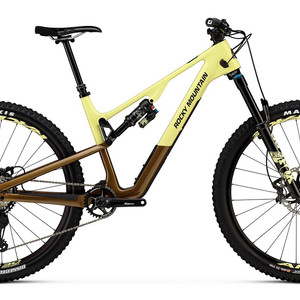

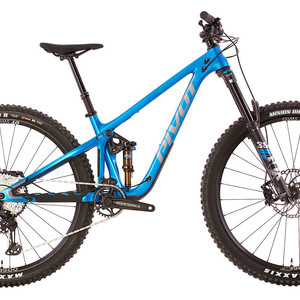
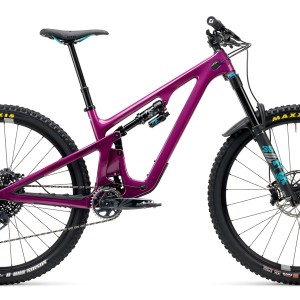

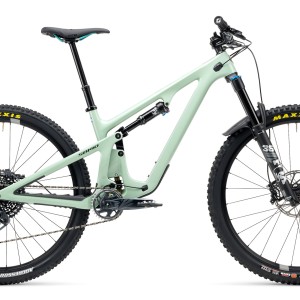
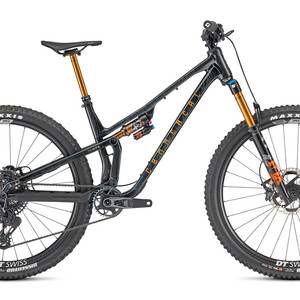
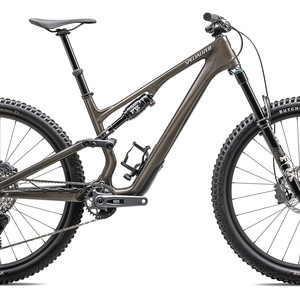







29 comments
Post a reply to: Tested: 2016 Yeti SB5.5c X01